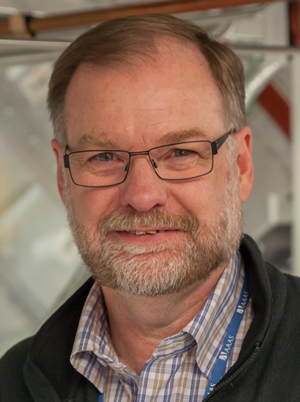NIF & PS People - 2016
April
Allan Casey Named an IET Fellow
Chris Barty Honored for Laser Science Work
NIF & Photon Science Chief Technology Officer Chris Barty has won the 2016 SPIE Harold E. Edgerton Award for his work on ultrafast lasers and laser-based x-ray and gamma-ray science. The award is presented annually for outstanding contributions to optical or photonic techniques in the application and understanding of high-speed physical phenomena. The development of new technologies and the new application of existing technologies are considered in the determination of the award.
 Chris Barty
Chris Barty Barty was cited for his “efforts in the development of foundational techniques that have enabled ultrafast, intense lasers and for pioneering contributions to time-resolved, x-ray and gamma-ray science conducted with such lasers.” He will receive his award at the summer meeting of the Society of Photo-optical Instrumentation Engineers (SPIE) in San Diego.
At LLNL, Barty has led R&D efforts to develop the kilojoule-class ultrahigh-intensity lasers which will soon be used to probe nuclear fusion at NIF, and has invented and developed new mono-energetic gamma-ray technologies that enable isotope-specific material detection, assay and imaging.
“I feel very honored to have won this award,” Barty said, “and to now be somehow associated with the legacy of ‘Doc’ Edgerton.”
Edgerton was an MIT professor known for his pioneering efforts to photographically capture fast physical events. In the 1950s, he produced the first photos of the initial phases of nuclear explosions. To do this, he created a 10-foot long-lens and the special triggering mechanisms so that the photo could be recorded at a “safe” distance.
While this work was National Nuclear Security Administration-relevant, Edgerton is better known for his work in stop motion photography.
Before coming to LLNL in 2000, Barty and his teams created record-setting, ultrafast, high-intensity laser systems and used these for numerous groundbreaking experiments including excitation of novel x-ray lasers, direct observation of non-thermal melting in semiconductor systems, and reduced-dose, time-gated medical imaging.
“My work, by its nature has always required a team effort and over the years has involved numerous talented researchers, staff and students,” Barty said. “Without the inspiration, efforts and camaraderie of these individuals, I could not have won this award.”
Barty earned bachelor degrees with honors in chemistry, physics and chemical engineering from North Carolina State University and a master’s and Ph.D. in applied physics from Stanford University.
He is a fellow of the Optical Society of America, SPIE, and the American Physical Society, a senior member of the Institute of Electrical and Electronics Engineers, and co-chair of the International Committee on Ultrahigh Intensity Lasers.
Prior to joining LLNL, Barty served as the director of advanced technology at Positive Light Inc. and chief executive officer of Positive Research Inc. as well as director of ultrafast science in the Department of Applied Mechanics & Engineering Science at UC San Diego. He also was a member of the faculty of the departments of applied physics and electrical engineering at Stanford.
Allan Casey Named an IET Fellow
LLNL computer engineer Allan Casey has been selected as a Fellow of the UK-based Institution of Engineering and Technology (IET), one of the world’s largest engineering institutions with more than 167,000 members in 127 countries.
 Allan Casey
Allan Casey IET fellowships are awarded to individuals who have sustained high levels of achievement, for example through leadership, influence, senior responsibility, innovation, and professional service, at the forefront of engineering, technology or cognate disciplines for a period of five years or more.
Casey has more than 22 years of experience in designing and building large-scale, mission-critical distributed control systems. He is currently the Data Systems Section lead in the NIF & Photon Science Directorate, managing a team of engineers who design and develop analysis, visualization, and shot-planning software systems to support experimental campaigns on NIF.
“On joining the IET in 1990,” Casey said, “becoming a Fellow has been my earliest and most consistent career goal.” He said IET fellowships are “awarded to those engineers who have made a significant contribution to engineering be it through education, leadership, volunteering or technology. Throughout my career I have tried to follow these principles in pursuit of this goal. The many opportunities offered at LLNL and NIF have enabled me to make such contributions.”
Casey received his bachelor’s degree in computer engineering from the University of Teesside in the UK. Prior to joining LLNL, he worked on the Eurofighter for British Aerospace and the Canadian Automated Air Traffic System for Raytheon. He joined the Laboratory in 2003 and was a technical team lead developing software for NIF’s Integrated Computer Control System, one of the largest and most complex experimental control systems in the world.
His recent work for Data Systems has involved working on user tools such as the NIF Proposal Management tool, which was developed using the SalesForce platform. Adoption of this technology was a first at LLNL. He also led the development of an iPad-based mobile checklist tool. By allowing NIF engineers and technicians to execute procedures with a touch of a screen rather than using bulky paper-based checklists, this tool has helped NIF operate more efficiently (see “Electronic Checklists Keep NIF Running Smoothly”).
Outside of work, he is the treasurer for the NorCal local network of the IET, coaches soccer, and volunteers with the Girl Scouts for Northern California.




